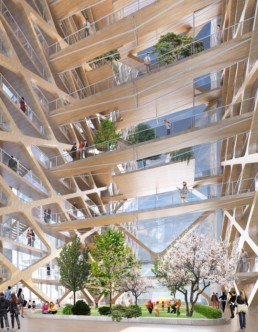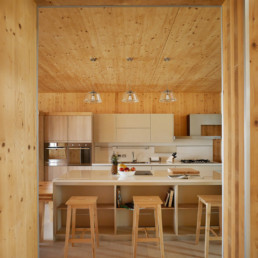May 15, 2018
This is the Future: 10 Most Eco-Friendly Wooden 'Plyscrapers'
William Le Baron Jenney’s Home Insurance Building was considered the first modern skyscraper; since then, cities all over the world have been building higher, reaching for the skies. In 2017 alone, a total of 128 skyscrapers over 200 meters tall were completed, 84 of which were in China. Buildings made from concrete and steel – the materials we currently use to build high – have a large carbon footprint and are slowly choking the atmosphere. In Britain, where the construction industry accounted for almost 7% of the economy (including 10% of total employment), 47% of greenhouse gas emissions were generated from buildings, while 10% of CO2 emissions came from construction materials. Cement production is the fastest-growing source of CO2 emissions according to recent UN Environmental Program Report, and accounts for 5-8% of world wide contribution. The development of engineered timber could herald a new era of eco-friendly ‘plyscrapers.’ See the growing list of proposed and completed wooden environmentally friendly skyscrapers around the world.
Japan’s government has long advertised the advantages of wooden buildings, and in 2010 passed a law requiring it be used for all public buildings of three stories or fewer. Sumitomo Forestry Co, A Japanese wood products company, is proposing to build a 350 metre (1,148ft), 70-floor tower to commemorate its 350th anniversary in 204. Sumitomo Forestry said the new building, known as the W350 Project, was an example of “urban development that is kind for humans”, with more high-rise architecture made of wood and covered with greenery “making over cities as forests” and turning Tokyo into an environmentally friendly city. 70% of the building will be constructed from wood, saving 200,800 tons of CO2 emissions over similar structures made of steel and concrete.

Wood Innovation and DesignPrince George, Canada
The Wood Innovation and Design Centre (WIDC) serves as a gathering place for researchers, academics, design professionals and others interested in generating ideas for innovative uses of wood. The University of Northern BC occupies the lower three floors of the building with facilities for the Master of Engineering in Integrated Wood Design Program. Upper floors provide office space for government and wood industry-related organizations, as well as the planned Emily Carr University of Art + Design Centre for Design Innovation and Entrepreneurship. The eight-storey building (6 storey with mezzanine plus penthouse), stands 29.5m tall — at the time of completion it was the world’s tallest modern all-timber structure, serving as a benchmark to be broken by other mass timber buildings in the works. Source: UBC
Achievements & Awards
- 2016 Governor General’s Medal in Architecture
- 2015 RAIC Award of Excellence for Innovation in Architecture
- 2015 Lieutenant-Governor of BC Award in Architecture (Merit)
- 2015 AIBC Innovation Award



Scandinavian firm CF Møller has revealed proposals that could see the world’s tallest timber-framed building constructed in Stockholm. As one of three shortlisted proposals in a housing design competition, the 34-storey Wooden Skyscraper is presented by architect CF Møller, architect Dinell Johansson and consultant Tyréns as a vision of future housing that would be cheaper, easier and more sustainable than typical steel and concrete constructions.
“The main reason it hasn’t been done before is that concrete and steel have a big part of the market,” CF Møller architect Ola Jonsson told Dezeen. “But now the building industry has started taking responsibility for the environment.”
He continued: “Construction accounts for around 30-40 percent of CO2 produced in the world globally and if you look at the CO2 released in the production of wood it is a lot better than steel or concrete.”
According to Jonsson, using wood could even be a cheaper alternative, as it is a lighter material that costs far less to transport. It is also more fire-resistant than steel or concrete.
“We have a long history of building wooden structures in Sweden,” he explains. “We have a higher knowledge of how to use the wood those days and we know that glued or nailed wood does have very strong construction qualities.”
If built, the 34-storey building would exceed the height of the nine-storey Murray Grove tower in London, as well as a proposed 20-storey tower in Vancouver by architect Michael Green and a Swedish tower approved at 30 floors. “I’ve seen sketches of other buildings, but we are definitely at the highest end of this discussion,” said Jonsson.
Wooden pillars, beams, walls, ceilings and window frames will all be visible through the building’s glass facade. The presented designs also include a concrete core, although Jonsson says this could be replaced with wood. “We believe a modern building should use every material for its best purpose,” he adds.
Wooden Skyscraper
For HSB Stockholm’s architectural competition 2023, three teams of architects have produced innovative proposals for private residences of the future at three different locations in the centre of Stockholm. Berg | C.F. Møller’s proposed design is a 34-storey skyscraper made of wood.
Berg | C.F. Møller Architects are working in partnership with architects Dinell Johansson and consultants Tyréns on their entry. The team has chosen to build upwards, and has designed a 34-storey residential building, which will be seen for miles.
The building will be built over a wooden construction with a concrete core, and it is intended to give the people of Stockholm a new and characteristic beacon and meeting place in their city.


Constructed from cross-laminated timber panels from the first floor upwards, Stadthaus is one of the tallest modern timber structure in the world. The nine-storey building is the first of this height to construct load bearing walls and floor slabs as well as stair and lift cores entirely from timber. Commissioned by Metropolitan Housing Trust and developed by housebuilder Telford Homes, the tower houses twenty-nine apartments with a neighbourhood office on the ground floor. The unique structure of the building is a result of the practice’s research in reducing the carbon emissions not only of the finished building but of the whole build process. The production of concrete and steel are very energy intensive, pumping tons of carbon dioxide into the atmosphere. In complete contrast timber stores carbon as it grows, meaning that this building stores 186 tonnes of carbon within its structure for its lifetime. The process of building in pre-fabricated timber is fast, the entire building was completed within forty-nine weeks. It is also incredibly accurate, and a healthy environment to both work on and live in. Upon its completion the building had zero defects and 100% tenants approval successfully demonstrating that solid timber construction is a financially viable, environmentally sustainable and beautiful replacement for concrete and steel in high-density housing.



As part of a masterplan along the Chicago River, the River Beech Tower is a residential high-rise which, if built, would be taller than any existing timber building. The collaborative team behind River Beech consists of architects Perkins+Will, engineers Thornton Tomasetti and the University of Cambridge. Currently a conceptual academic and professional undertaking, the team state that it could potentially be realized by the time of the masterplan’s final phases.
The team believes that they will be able to “reach far greater heights than any existing timber building” using only “real, commercially available timber materials.” Existing timber skyscraper proposals come in at around 30-40 stories, such as C.F. Møller and DinellJohnasson’s 34-story residential building in Stockholm, set to be completed in 2023. SOM have also developed a system that shows the possibility of a 42-story building as part of their Timber Tower Research Project. Completed or soon-to-be complete timber buildings stand a little shorter, with Acton Ostry Architects’ 18-story student residence currently under construction in Vancouver and the 10-story Forte apartment building in Melbourne.
Structurally, these existing buildings make use of a hybrid system of engineered timber (cross-laminated and glulam) and concrete (often in the core), to achieve their heights. Slightly different to these systems is Michael Green’s “Finding the Forest Through the Trees” (FFTT) construction model, which has a wooden core and wooden floor slabs, with steel beams to provide ductility–essentially, as steel is able to stretch more than wood, these beams hold the structure together under extreme lateral loads such as in an earthquake or high winds.
The River Beech team however, use a different system entirely, and credit this innovation as their key to new wooden heights. The system engages an exterior diagrid system, taking advantage of the natural axial strength of timber. The building’s vertical and lateral loads are resisted by connecting the outer diagrids with the internal cross bracing that skirts the central atrium, allowing for efficient load distribution across all timber elements.
At 80 stories tall, the conceptual brief caters for 300 duplex units and multi-story penetrations that form communal spaces. The play between private and public within a carbon-neutral structure ties together the team’s vision of their “social and sustainable adaptation to high-rise development.”
Design Credits:
Courtesy of River Beech Tower
Perkins+Will Project Team:
Ralph Johnson, Todd Snapp, Jeff Sanner, Rachael Bennett, Gilryong Song
Thornton Tomasetti Project Team:
David Weihing, Edward Peck, Alejandro Fernandez, Mark Chiu, Timothy Wong
University of Cambridge Project Team:
Michael Ramage, Rob Foster


WoodTek HQ / Origin - Taiwan
Text description provided by the architects. Overlooking the Farze Crook by the high speed train rail, WoodTek headquarters building is the first ever CLT building in Taiwan.
We wanted this architecture to be a landmark not just in it’s physical appearance but also as a symbolic approach of Green Architecture development in Asia. Should this CLT building proves to be successful, the landscape of Taiwan’s concrete dominated urban jungle will change dramatically. Until today, most of the buildings in Taiwan’s urban area are built out of concrete which is against global movement toward low carbon and eco friendly Green Architecture.
CLT construction will provide more opportunities for users in urban area to utilize wood, a renewable green material, for both low rise and high rise buildings ; for the private and the public.
To design a CLT building in Taiwan, we have to face several challenges. The first one is the Durability of CLT building in hot and humid climate condition in Taiwan. Pressure Equalized Rainscreen System is applied in this building’s envelope to prevent wind driven water into building assemblies. First floor is raised above ground and sits on top of concrete basement to keep away moisture from soil and to prevent attacks from Formosan Subterranean Termites. Termites’ attack might be minor issue in most of the European countries but is a major concern in Taiwan. “How to keep the building Dry” becomes one of the major issues throughout design and construction process.



The Hyperion - Bordeaux by Jean-Paul ViguierBordeaux, France
France is to make its first attempt at timber tower construction with two tall wooden buildings in Bordeaux, said a report.
The towers, reaching 50m and 57m in height, will be developed in the centre of the city by Bordeaux Euratlantique, a public body involved in modernising Bordeaux, reported the Global Construction Review.
The project team for “Hypérion”, the 18-storey residential tower, will include Eiffage, specialist wood contractor Woodeum, social landlord Clairsienne and architect Jean-Paul Viguier & Associés. When complete, it will contain 82 apartments.
“Wood of this type is as good at resisting fire as concrete. The CLT we use is very solid: the first flame does not appear until 400°C,” he explained.
The 50m office tower is to be built by a team led by French developer Kaufman & Broad to a design by local architect Art & Build. This building, which has been dubbed “Silva”, will be 80 per cent made from locally sourced cross-laminated timber (CLT) with glulam plywood bracing, said the report.
Scheduled for completion in 2020, the towers will be part of the new Belvedere quarter adjacent to the city’s Saint-Jean station, it added.
Brock Commons, the World's Tallest Mass Timber BuildingVancouver, Canada
Brock Commons Tallwood House, the recently completed student residence building at the University of British Columbia (UBC) in Vancouver, now occupies a prominent position within architecture: the tallest building with a timber structure in the world.
Designed by the Canadian practice Acton Ostry Architects Inc., the project was a collaborative effort of a number of leading companies and consulting firms including Fast + Epp, Austria-based Architekten Hermann Kaufmann, and GHL Consultants Ltd., along with the renowned manufacturer of mass timber products and packages, Structurlam.
“We found that working with wood, we could reduce timelines for construction. The assembly of the wood structure went up incredibly quickly, faster than we even expected”, explained John Metras, Managing Director of Infrastructure Development at UBC.
Stretching up to a height of 53 meters, the building houses 404 students and comprises a mix of one-bedroom and studio units, study and social spaces, and a student lounge on the topmost floor. With the design and construction team working in tandem from the very beginning, the process was streamlined by a thorough testing of wood-to-wood connections on a two-story mock-up prior to on-site construction. This not only allowed the team to test structural stability, but also helped perfect the timeline of the project.
Even more pertinent to the prefabrication process was a detailed 3-D model, which helped various departments to collaboratively discuss and apply ideas prior to finalizing them for actual fabrication or construction. Owing to meticulous planning and the efficient integration of construction and design processes, Brock Commons was completed within a mere 70 days after the prefabricated components were ready for assembly – considerably shorter than the amount of time it would have taken to complete a concrete building of the same size.


Oakwood TowerLondon, UK
A team of leading architects has unveiled plans for London’s first ever wooden skyscraper.
The group from Cambridge University want to build a 1,000ft structure off the edge of the Barbican, in the City of London, and the designers hope that 1,000 homes can be created across its 80-storeys.
The Oakwood Tower would have a completely timber frame and its 93,000 sqm floor plan would also include terraced housing.
The concept was put to London mayor Boris Johnson and if it goes ahead it will be London’s second tallest building after The Shard – and the tallest wooden structure in the world.
Michael Romage, director of Cambridge’s Centre for Natural Material Innovation, said: ‘The Barbican was designed in the middle of the last century to bring residential living into the city of London and was successful.
‘If London is going to survive it needs to increasingly densify and one way is with taller buildings. We believe people have a greater affinity for taller buildings in natural materials rather than steel and concrete towers.’
Timber has been used to make homes for more than 2,000 years and it is being heralded as a lightweight and sustainable substitute for traditional construction materials.
The sky scraper would certainly catch the eye on London’s ever-changing skyline, but while it would be unique in our capital – there are others like it in cities around the world.
The tallest existing wooden building is a 14-storey apartment block in Bergen, Norway, but several more are planned in France and Sweden.


Anders Berensson Architects was commissioned by the Stockholm Center Party to design a skyscraper to replace an old car park in the city center of Stockholm. The result became a slender wood scraper “Trätoppen” (the tree top) that stands inside the car park leaving the existing car parks facade intact.
If we want to reduce the amount of cars in the city center of Stockholm and at the same time make space for more housing without building on green areas, then replacing car parks with housing, shops and restaurants feels obvious. If the car park is as central located as the one on Regeringsgatan 47 it also make sense to build a high building that can fit a lot of people, shops and restaurants.
The existing car park, “Parkaden”, is perhaps Sweden’s most famous one designed by Hans Asplund. The most characteristic feature of the house is a pattern with numbers on the facade which shows what floor you are on. Another thing that distinguishes this car park is the early use of a system of sloped floors. Retaining the sloping floor is hard due to the buildings low ceiling height, however it is possible to maintain the facade if the new building don’t use the whole footprint of the existing car park.
The skyscraper is retracted six meters from the existing car parks facade in order not to interfere too much with the expression of the car park . The Skyscraper is considerably smaller in foot print than the car park which enables space for a large public terrace on the seventh floor. The retraction also makes it possible to use the existing building at the lower floors after an extensive reconstruction.
The new building will be 40 stories high and built out of cross laminated timber “CLT”. In the 33 floors that protrude above the existing car park 31 floors will be residential and 2 floors will be public terraces. The seven floors inside the existing car park is best suited for shopping and restaurants due to the depth of the house. The CLT facade of the new skyscraper is a continuation of the pattern with numbers that Hans Asplund designed. From the outside, one can count the floors by reading the facade and from the inside you will be reminded what floor you are on just like in the parking garage. This is a useful feature given that the skyscraper will be the highest in the city center of Stockholm. The facade also has some practical benefits and acts like a sun screen, which keeps the building cool and energy efficient.
See Anders Berensson – Architects











